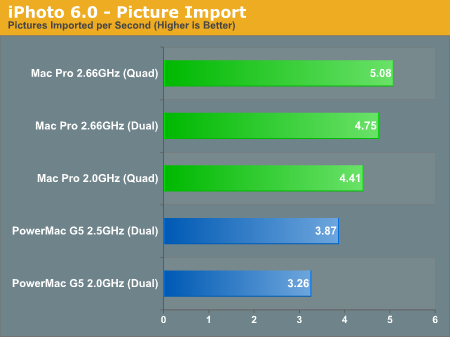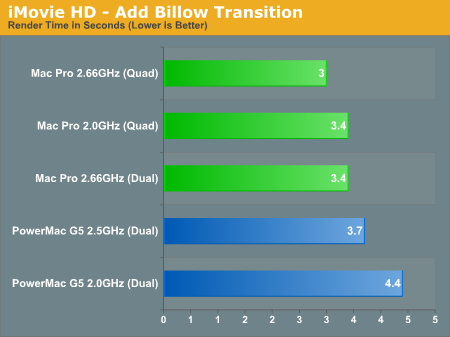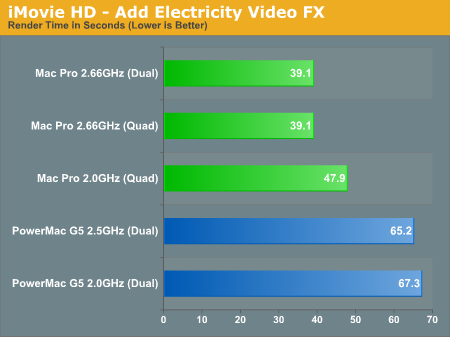Apple's Mac Pro - A True PowerMac Successor
by Anand Lal Shimpi on August 16, 2006 12:27 PM EST- Posted in
- Mac
iLife '06 Performance with iPhoto, iMovie HD and iDVD
One of the benefits of OS X and Apple's application suites is that most of the applications are already properly threaded. Even though you wouldn't expect it, iPhoto is threaded quite well and thus our import photos test gets a speedup from going to quad cores.
The test is simple; we timed the import of 379 photos into iPhoto which, believe it or not, is quite CPU intensive and not as I/O bound as you'd think. After we got the time we divided it into 379 to get the number of pictures imported per second. We included the performance of a hypothetical dual core Mac Pro in addition to the native quad offerings in order to provide a good point of comparison to the dual processor PowerMac G5s.

Although there's a slight performance boost when going from dual to quad core (6.9%), this test is largely dependent on clock speed within a single microprocessor architecture. Comparing the Woodcrest based Xeons to the older G5s is no contest, at 2.0GHz the Mac Pro is already 14% faster than the 2.5GHz PowerMac G5; even if we account for the dual vs. quad core comparison, the 2.0GHz Mac Pro is still noticeably faster than the G5.
The next application we looked at was iMovie HD. There are two primary focuses for performance in iMovie HD, video import speed (if you are dealing with a non-DV or non-iSight video source) and effect rendering speed. We focused on the latter, measuring the time it takes to render the most CPU intensive transition and video effect in iMovie HD.

Our Macs have gotten a little too fast for the billow transition test, as the Mac Pro 2.66GHz can now complete the test in 3 seconds flat. All of the Mac Pros here are faster than the PowerMac G5s, which is what we'd expect given what we learned in the iMac Core Duo vs. iMac G5 article.

Rendering the "Electricity" Video FX sees no benefit going from dual to quad cores, but the Mac Pro doesn't need it as the 2.0GHz configuration is already 26.5% faster than the PowerMac G5 2.5GHz.
Finally we've got iDVD, an application that you can use to create DVDs that are playable on any consumer DVD player. There are once again two aspects to performance in iDVD, video encoding performance and menu encoding performance. Since we've already looked at video encoding performance with Quicktime, this test is predominantly limited by how long it takes to encode the menu system in our test DVD. There is a small 13 second iSight video and audio that's encoded in the process but it adds a matter of seconds to the overall time. The image is written to disc instead of sent to the DVD burner for obvious reasons. The results are expressed in seconds, lower being better. This workload is multithreaded.

The benchmark gets just under 11% thanks to the 4 cores in the Mac Pro, but even without them the Mac Pro 2.66GHz is able to outperform the PowerMac G5 2.5GHz by just under 13%. The Xeon seems to scale much better with clock speed in this test than the G5.










96 Comments
View All Comments
plinden - Thursday, August 17, 2006 - link
I know of at least one multithreaded LAME encoder for iTunes, but I've never used it so don't know how fast it is - http://www.versiontracker.com/dyn/moreinfo/macosx/...">http://www.versiontracker.com/dyn/moreinfo/macosx/...Maury Markowitz - Wednesday, August 16, 2006 - link
The MP3 process itself might not be, but the load -> encode -> write process most certainly is threadable.Maury
Questar - Wednesday, August 16, 2006 - link
Reading and writing a file most likely doesn't use very much in system resources.Dennis Travis - Wednesday, August 16, 2006 - link
Good job Anand. I can't wait for the next part!!WeirdZen - Wednesday, August 16, 2006 - link
Something I have not seen mentioned is support for Video Cards. Now that these are using a different Bios, can we use standard PC Video Cards, or are we still forced to pay too much money for a slim selection of cards?Maury Markowitz - Wednesday, August 16, 2006 - link
The basic answer is "no, but it is likely you can make them work with some effort". There are two basic problems, one is the boot firmware on the card, and the other is the drivers in the Mac OS (or lack thereof). Both can be addressed, and have been in the past. Here's the scoop:The firmware on the basic PC card is basically aimed at getting a BIOS-based machine up and running. Since the Mac uses EFI, this doesn't work, and a PC card in a Mac simply won't boot (nothing bad happens though, just nothing happens). The Mac cards replace this BIOS-based code with one that appears to work fine on both BIOS and EFI machines. So basically a Mac card will work fine in any PC, but most PC cards will not run in the Mac. EFI is expected to become more common in the future though, so we'll have to see how this turns out six months from now.
Now it's just firmware. That means you can download it from a Mac version and upload it to a PC version and presto. The problem here is that the combination on the Mac drive ends up being larger, which shouldn't be surprising. So while most PC cards have a 64k flash on them for the firmware, the Mac version is about 110k and needs a 128k flash. SOME PC cards have this, but generally it's rare.
Things are not so bad as they seem. In the past hackers have been able to strip out the PC-only code, leaving a smaller Mac-only version that will fit into 64k. It will be a little while before we know if this is possible for the EFI driver too, it's simply too early to know yet. Another option is to solder a 128k flash onto your card, but obviously that's much more "serious".
The other issue is the drivers in the Mac OS. Every card has a unique ID and vendor code in it, and the Mac OS tries to look up cards by pattern matching on these IDs. So even if you did flash the firmware, the Mac wouldn't find the driver matching those codes, and fail to load it. The news here is very good though, because Apple puts practically everything into normal text files, including these codes. It's a triviality to find them in the driver and change them to match your card.
So we'll all just have to wait a bit and see how it all turns out. The basic long-n-short is that its definitely _possible_ in theory.
Finally, a word or two about SLI/CrossFire. These are a different matter entirely. Basically these systems use custom drivers that split every message being sent out of the video drivers and sends them to both cards at the same time. That way they both have an identical copy of the "world". Clearly the normal drivers cannot be used, and unless someone makes a driver for the Mac, these things simply aren't going to work.
There is one oddball though, the GeForce 7950 GX2. This card is basically two 7900's bolted together, with SLI _internal_. From what I understand, the machine and OS has no idea that it's not talking to a bog-standard 7900. Assuming all the problems above can be worked out, it is just possible that the Quattro driver Apple has now could be adapted to work with this card. THAT would be good enough for me, Halo runs full-screen on a 30" LCD on this card...
Maury
Pirks - Wednesday, August 16, 2006 - link
yeah Anand please tell us if we can buy nice cheap evga 7900GT and stick it inside this fruity beastVooDooAddict - Wednesday, August 16, 2006 - link
I think this is a burning question amoung those of us thinking about this beast.ViRGE - Wednesday, August 16, 2006 - link
Early results look like it won't happen. For Mac OS X, the card needs to support EFI, which means there needs to be a portion of the video BIOS programmed to handle it. Right now only Mac-specific cards seem to be able to do so, and PC cards can't be flashed because the Mac cards are using a larger EEPROM for the BIOS.delta53 - Wednesday, August 16, 2006 - link
They go on and on about the price difference and fail to tell you that the Apple doesn't include at monitor or a protection plan which the price of the dell includes both. The price for the apple plan is $249 for 3 years. Dell will take off $149 for the monitor. Therefore, the Apple with protection plan without monitor is $2748.00 and the Dell with the protection plan without monitor is $2961.00. Price difference $213.00. That is comparing apples to apples.